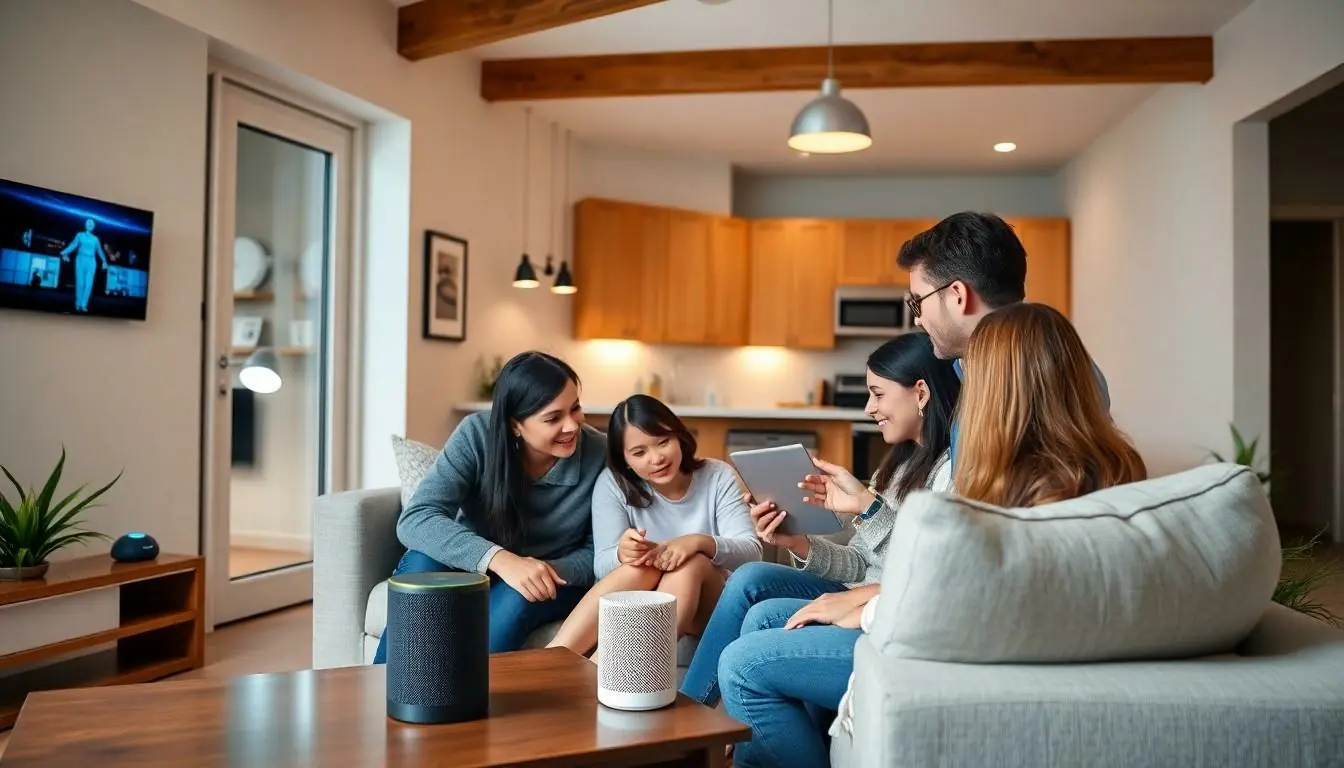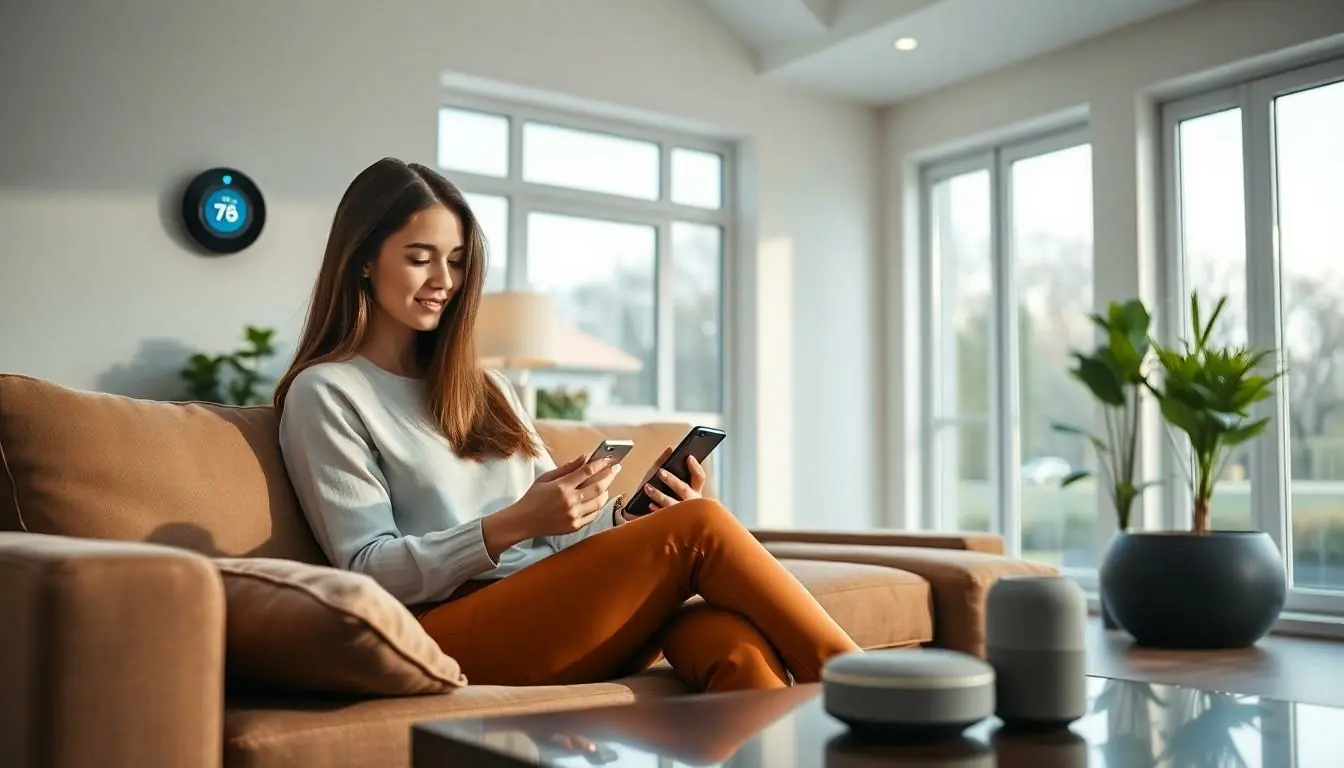Imagine walking into your home and having it greet you like a long-lost friend. Lights dance to life, music starts playing your favorite tunes, and the coffee pot brews your morning elixir—all without lifting a finger. Welcome to the world of smart homes, where technology meets convenience in a way that’ll make your neighbors green with envy.
Table of Contents
ToggleUnderstanding Smart Homes
Smart homes utilize modern technology to create an automated and connected living environment. These homes respond to the occupants’ needs through various integrated devices and systems.
What Is a Smart Home?
A smart home refers to a residence equipped with devices that allow remote management and monitoring. Systems include lighting, heating, and security that users can control via smartphones or voice assistants. Automation plays a crucial role, enabling schedules and routines that enhance comfort and efficiency. Many devices work together, creating an ecosystem that learns homeowner preferences for increased convenience.
Benefits of a Smart Home
Smart homes offer numerous advantages that significantly improve daily living experiences. Energy efficiency often tops the list, as automated systems optimize usage and reduce waste. Enhanced security features, including smart cameras and door locks, provide peace of mind. Convenience is palpable, with users controlling home features from anywhere at any time. Home automation facilitates multitasking by executing mundane tasks effortlessly, making everyday life simpler and more enjoyable.
Planning Your Smart Home

Planning your smart home involves careful consideration of goals and budgets. It’s essential to establish a clear vision of how technology will enhance daily living.
Setting Your Goals
Defining specific goals is crucial for a successful smart home. Determine which areas, such as security, energy efficiency, or convenience, hold the highest priority. Setting goals allows for focused investment in essential technologies. For example, someone might prioritize security enhancements through smart cameras and door locks, while another may opt for energy management solutions like smart thermostats. Understanding these desired outcomes directs product selection and system integration, ensuring that choices align with lifestyle needs.
Budget Considerations
Establishing a budget is vital for a smart home project. Analyze available funds before selecting devices and systems. Considerations for initial costs include smart speakers, lighting, and security systems. In addition, account for potential installation fees and ongoing subscription costs for services. Balancing quality and affordability leads to smart purchases. Assessing financing options can also extend the budget, making advanced technologies accessible. Establishing a budget limits overspending while maximizing benefits across various components of the smart home.
Choosing Smart Devices
Choosing the right smart devices is essential for creating an efficient and functional smart home. Smart technology offers a variety of options that can significantly enhance everyday life.
Key Categories of Smart Devices
Smart devices typically include categories such as lighting, security, heating, and entertainment systems. Smart lighting allows users to control brightness and color remotely. Security devices encompass smart cameras, door locks, and alarms for enhanced safety. Heating systems include smart thermostats that adjust based on usage patterns, while entertainment devices provide automated control over audio and video experiences. Energy management devices monitor consumption and improve efficiency across the home.
Top Brands and Products
Reputable brands lead the smart device market with innovative solutions. Philips Hue offers popular smart lighting options, while Ring excels in security cameras and doorbells. Nest stands out in the thermostat category, providing energy-efficient heating systems. Amazon Echo and Google Nest Hub serve as effective voice assistants, managing various smart devices with ease. Additionally, Ecobee delivers smart thermostat technology with advanced features, making energy savings accessible. Each brand brings unique strengths, so evaluating specific needs is crucial for choosing the best options.
Installation and Setup
Smart home installation can either be a DIY project or a professional undertaking, depending on individual preferences and technical skills. Many homeowners enjoy the satisfaction of installing devices themselves, while others appreciate the peace of mind that comes from hiring experts.
DIY vs. Professional Installation
Choosing between DIY and professional installation often depends on complexity. DIY options suit users comfortable with technology and troubleshooting. With clear instructions, many smart devices can be easily set up without special skills. Conversely, professional installation ensures everything runs smoothly, particularly for advanced systems like home security or HVAC integration. Professionals bring expertise to avoid common pitfalls, especially with complicated configurations. Evaluating personal comfort levels and the specific requirements of selected devices often guides this decision.
Common Setup Challenges
Several challenges may arise during smart home setup. Connectivity issues frequently occur, especially with Wi-Fi-dependent devices. Ensuring strong signals in every room often requires network upgrades or additional access points. Compatibility between devices is another hurdle. Some products may not integrate as advertised, leading to frustrating experiences. Users might also face learning curves with new apps or interfaces. Troubleshooting can take time, particularly when syncing multiple devices. Being prepared for these challenges often helps streamline the installation process and enhances long-term satisfaction.
Ensuring Security and Privacy
Smart homes require a deliberate focus on security and privacy. As technology becomes more integrated into daily life, protecting personal information and space is vital.
Best Practices for Smart Home Security
Implement strong passwords for every smart device. Use unique combinations of letters, numbers, and symbols for each account. Regularly update firmware and software to patch security vulnerabilities. Choose devices that support two-factor authentication, adding another layer of security. Secure Wi-Fi networks by using encryption protocols like WPA3. Position cameras and motion sensors wisely to cover critical areas without infringing on privacy. Lastly, create a dedicated network for smart devices, separating them from personal devices.
Managing Data Privacy
Assess data collection practices before purchasing devices. Understand what information manufacturers collect and how it’s processed. Review privacy settings on devices and adjust them to minimize data sharing. Regularly check app permissions and limit access to essential functions only. Read privacy policies to ensure the company adheres to robust protection measures. Additionally, use virtual private networks (VPNs) when accessing devices remotely to safeguard data transmission. These steps foster a proactive approach to managing privacy in a connected home environment.
Creating a smart home is an exciting journey that transforms daily living into a more efficient and enjoyable experience. By carefully planning and selecting the right devices, homeowners can tailor their environments to meet specific needs. Prioritizing security and privacy ensures peace of mind while embracing technology.
As smart home technology continues to evolve, staying informed about new innovations will enhance the living experience even further. With the right approach and a focus on personal preferences, anyone can turn their home into a smart sanctuary that simplifies life and enhances comfort. Embracing these advancements not only improves convenience but also contributes to a more sustainable and connected future.



